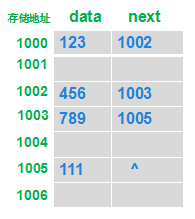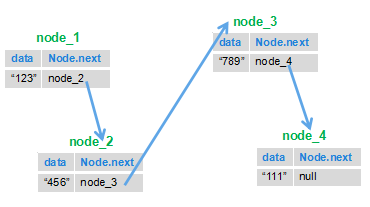單向連結串列的原理及java實現
阿新 • • 發佈:2019-02-14
一:單向連結串列基本介紹
連結串列是一種資料結構,和陣列同級。比如,Java中我們使用的ArrayList,其實現原理是陣列。而LinkedList的實現原理就是連結串列了。連結串列在進行迴圈遍歷時效率不高,但是插入和刪除時優勢明顯。下面對單向連結串列做一個介紹。
單向連結串列是一種線性表,實際上是由節點(Node)組成的,一個連結串列擁有不定數量的節點。其資料在記憶體中儲存是不連續的,它儲存的資料分散在記憶體中,每個結點只能也只有它能知道下一個結點的儲存位置。由N各節點(Node)組成單向連結串列,每一個Node記錄本Node的資料及下一個Node。向外暴露的只有一個頭節點(Head),我們對連結串列的所有操作,都是直接或者間接地通過其頭節點來進行的。
上圖中最左邊的節點即為頭結點(Head),但是新增節點的順序是從右向左的,新增的新節點會被作為新節點。最先新增的節點對下一節點的引用可以為空。引用是引用下一個節點而非下一個節點的物件。因為有著不斷的引用,所以頭節點就可以操作所有節點了。
下圖描述了單向連結串列儲存情況。儲存是分散的,每一個節點只要記錄下一節點,就把所有資料串了起來,形成了一個單向連結串列。

節點(Node)是由一個需要儲存的物件及對下一個節點的引用組成的。也就是說,節點擁有兩個成員:儲存的物件、對下一個節點的引用。下面圖是具體的說明:
二、單項鍊表的實現
package com.zjn.LinkAndQueue; /** * 自定義連結串列設計 * * @author zjn * */ public class MyLink { Node head = null; // 頭節點 /** * 連結串列中的節點,data代表節點的值,next是指向下一個節點的引用 * * @author zjn * */ class Node { Node next = null;// 節點的引用,指向下一個節點 int data;// 節點的物件,即內容 public Node(int data) { this.data = data; } } /** * 向連結串列中插入資料 * * @param d */ public void addNode(int d) { Node newNode = new Node(d);// 例項化一個節點 if (head == null) { head = newNode; return; } Node tmp = head; while (tmp.next != null) { tmp = tmp.next; } tmp.next = newNode; } /** * * @param index:刪除第index個節點 * @return */ public boolean deleteNode(int index) { if (index < 1 || index > length()) { return false; } if (index == 1) { head = head.next; return true; } int i = 1; Node preNode = head; Node curNode = preNode.next; while (curNode != null) { if (i == index) { preNode.next = curNode.next; return true; } preNode = curNode; curNode = curNode.next; i++; } return false; } /** * * @return 返回節點長度 */ public int length() { int length = 0; Node tmp = head; while (tmp != null) { length++; tmp = tmp.next; } return length; } /** * 在不知道頭指標的情況下刪除指定節點 * * @param n * @return */ public boolean deleteNode11(Node n) { if (n == null || n.next == null) return false; int tmp = n.data; n.data = n.next.data; n.next.data = tmp; n.next = n.next.next; System.out.println("刪除成功!"); return true; } public void printList() { Node tmp = head; while (tmp != null) { System.out.println(tmp.data); tmp = tmp.next; } } public static void main(String[] args) { MyLink list = new MyLink(); list.addNode(5); list.addNode(3); list.addNode(1); list.addNode(2); list.addNode(55); list.addNode(36); System.out.println("linkLength:" + list.length()); System.out.println("head.data:" + list.head.data); list.printList(); list.deleteNode(4); System.out.println("After deleteNode(4):"); list.printList(); } }
三、連結串列相關的常用操作實現方法
1. 連結串列反轉
/** * 連結串列反轉 * * @param head * @return */ public Node ReverseIteratively(Node head) { Node pReversedHead = head; Node pNode = head; Node pPrev = null; while (pNode != null) { Node pNext = pNode.next; if (pNext == null) { pReversedHead = pNode; } pNode.next = pPrev; pPrev = pNode; pNode = pNext; } this.head = pReversedHead; return this.head; }
2. 查詢單鏈表的中間節點
採用快慢指標的方式查詢單鏈表的中間節點,快指標一次走兩步,慢指標一次走一步,當快指標走完時,慢指標剛好到達中間節點。
/**
* 查詢單鏈表的中間節點
*
* @param head
* @return
*/
public Node SearchMid(Node head) {
Node p = this.head, q = this.head;
while (p != null && p.next != null && p.next.next != null) {
p = p.next.next;
q = q.next;
}
System.out.println("Mid:" + q.data);
return q;
}3. 查詢倒數第k個元素
採用兩個指標P1,P2,P1先前移K步,然後P1、P2同時移動,當p1移動到尾部時,P2所指位置的元素即倒數第k個元素 。
/**
* 查詢倒數 第k個元素
*
* @param head
* @param k
* @return
*/
public Node findElem(Node head, int k) {
if (k < 1 || k > this.length()) {
return null;
}
Node p1 = head;
Node p2 = head;
for (int i = 0; i < k; i++)// 前移k步
p1 = p1.next;
while (p1 != null) {
p1 = p1.next;
p2 = p2.next;
}
return p2;
}4. 對連結串列進行排序
/**
* 排序
*
* @return
*/
public Node orderList() {
Node nextNode = null;
int tmp = 0;
Node curNode = head;
while (curNode.next != null) {
nextNode = curNode.next;
while (nextNode != null) {
if (curNode.data > nextNode.data) {
tmp = curNode.data;
curNode.data = nextNode.data;
nextNode.data = tmp;
}
nextNode = nextNode.next;
}
curNode = curNode.next;
}
return head;
}5. 刪除連結串列中的重複節點
/**
* 刪除重複節點
*/
public void deleteDuplecate(Node head) {
Node p = head;
while (p != null) {
Node q = p;
while (q.next != null) {
if (p.data == q.next.data) {
q.next = q.next.next;
} else
q = q.next;
}
p = p.next;
}
}6. 從尾到頭輸出單鏈表,採用遞迴方式實現
/**
* 從尾到頭輸出單鏈表,採用遞迴方式實現
*
* @param pListHead
*/
public void printListReversely(Node pListHead) {
if (pListHead != null) {
printListReversely(pListHead.next);
System.out.println("printListReversely:" + pListHead.data);
}
}7. 判斷連結串列是否有環,有環情況下找出環的入口節點
/**
* 判斷連結串列是否有環,單向連結串列有環時,尾節點相同
*
* @param head
* @return
*/
public boolean IsLoop(Node head) {
Node fast = head, slow = head;
if (fast == null) {
return false;
}
while (fast != null && fast.next != null) {
fast = fast.next.next;
slow = slow.next;
if (fast == slow) {
System.out.println("該連結串列有環");
return true;
}
}
return !(fast == null || fast.next == null);
}
/**
* 找出連結串列環的入口
*
* @param head
* @return
*/
public Node FindLoopPort(Node head) {
Node fast = head, slow = head;
while (fast != null && fast.next != null) {
slow = slow.next;
fast = fast.next.next;
if (slow == fast)
break;
}
if (fast == null || fast.next == null)
return null;
slow = head;
while (slow != fast) {
slow = slow.next;
fast = fast.next;
}
return slow;
}

